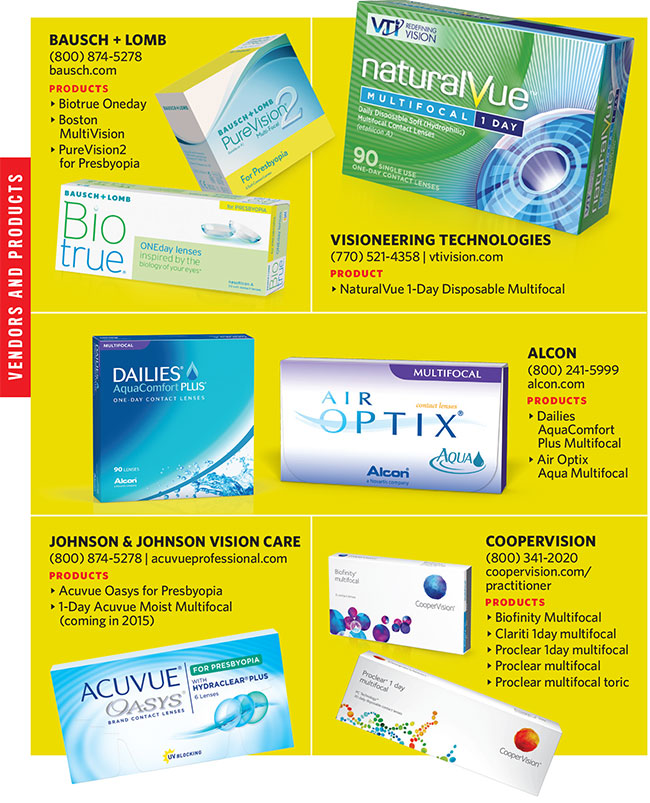Multifocal contact lenses hold promise as a big growth category for ECPs, especially among members of Generation X. Those at the leading edge of this group are just getting acquainted with presbyopia. But they also grew up wearing contacts — and no matter how hip glasses get, many people in their 40s are reluctant to start wearing them. (Bausch + Lomb’s consumer website address for its multifocals? goodbyereaders.com.)
Advances in multifocal contacts make them a good bet for more wearers, yet many people still experience difficulty getting a good fit for all distances. For these patients, keep an eye on product introductions. For example, Visioneering Technologies plans an early 2015 launch for its recently approved NaturalVue Multifocal 1 Day Disposables, with one “Universal” ADD for up to 3.00D of equivalent near power, and technology “inspired by how a camera aperture channels light,” according to the company’s news release.
Many people who might benefit from multifocal contacts don’t know the lenses exist. So make a point to talk about them with your patients. — JULIE FANSELOW
This article originally appeared in the January 2015 edition of INVISION.

Advertisement
Smart Ways to Sell More Multifocal Contacts
 Talk with the patient about day-to-day activities and visual comfort throughout the day. This can provide insight into whether the patient may have an underlying anterior surface medical eye condition to address before a contact lens fitting. — Dr. Millicent Knight, Johnson & Johnson Vision Care
Talk with the patient about day-to-day activities and visual comfort throughout the day. This can provide insight into whether the patient may have an underlying anterior surface medical eye condition to address before a contact lens fitting. — Dr. Millicent Knight, Johnson & Johnson Vision Care
 I’ve found that many patients ignore the small, slow changes their eyes are undergoing. Most do not know there is new contact lens technology available, so they are not asking or voicing their concerns about their eyestrain at near distances while in their doctor’s offices. — Dr. Rhonda Robinson, Bausch + Lomb
I’ve found that many patients ignore the small, slow changes their eyes are undergoing. Most do not know there is new contact lens technology available, so they are not asking or voicing their concerns about their eyestrain at near distances while in their doctor’s offices. — Dr. Rhonda Robinson, Bausch + Lomb
 For an early presbyope, I tell the patient how much better they will feel especially at the end of the day when their eyes are relaxed from their near work. These patients are many times in denial about aging and don’t consider multifocal lenses because they can still see up close, even though they have to increase font size or hold their arms out. — Robinson
For an early presbyope, I tell the patient how much better they will feel especially at the end of the day when their eyes are relaxed from their near work. These patients are many times in denial about aging and don’t consider multifocal lenses because they can still see up close, even though they have to increase font size or hold their arms out. — Robinson
 Discuss the changes that accompany presbyopia, especially for people who do continuous near-point work. Demonstrate or discuss how the symptoms may appear: tromboning material from near to far, eye fatigue, and eyes watering. — Knight
Discuss the changes that accompany presbyopia, especially for people who do continuous near-point work. Demonstrate or discuss how the symptoms may appear: tromboning material from near to far, eye fatigue, and eyes watering. — Knight
Advertisement
 For more mature presbyopes, I tell them how much better they will see with the ability to look in all directions at all distances, near, far and everywhere in-between, which is a considerable advantage over multifocal glasses. No more distorted vision when walking up and down stairs, no more having to point their nose to what they want to see, no more having to lift their chin to see the computer which sits straight in front of them, and no more having to hunt for misplaced reading glasses. Fitting multifocal contact lenses is an opportunity to improve the quality of presbyopic patients’ lives. — Robinson
For more mature presbyopes, I tell them how much better they will see with the ability to look in all directions at all distances, near, far and everywhere in-between, which is a considerable advantage over multifocal glasses. No more distorted vision when walking up and down stairs, no more having to point their nose to what they want to see, no more having to lift their chin to see the computer which sits straight in front of them, and no more having to hunt for misplaced reading glasses. Fitting multifocal contact lenses is an opportunity to improve the quality of presbyopic patients’ lives. — Robinson
 Talk about options for addressing presbyopia including multifocals. Set expectations for how they can best enhance the majority of visual needs. Emphasize that contact lenses may be worn full- or part-time, depending on individual needs. Have staff available who can train new contact lens wearers. Boost compliance and customer satisfaction by having contact lenses in inventory. — Knight
Talk about options for addressing presbyopia including multifocals. Set expectations for how they can best enhance the majority of visual needs. Emphasize that contact lenses may be worn full- or part-time, depending on individual needs. Have staff available who can train new contact lens wearers. Boost compliance and customer satisfaction by having contact lenses in inventory. — Knight